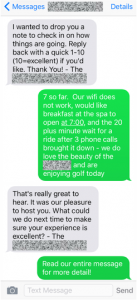Customer feedback is the lifeblood of CX programs. But as customers receive more frequent survey invitations, they may be less likely to respond to many requests for feedback. Survey fatigue is a real and pervasive problem.
But the solution to this challenge may be in our hands—or our pockets, or within easy reach.
Mobile devices are everywhere. In fact, as of 2014, cell phone adoption climbed to nearly 100% for adults between the ages of 18 and 49. And texting is the preferred mode of communications for adults below age 50.
Another important research finding: over 80% of mobile users read every text they receive—even from contacts they do not recognize.
For CX practitioners, widespread mobile and texting adoption offers new opportunities to connect with customers. Using SMS to survey customers can offer an efficient path to collecting feedback. Already a common feedback gathering method in Europe and Asia, SMS surveys are gaining traction in the U.S.
As more brands adopt SMS feedback gathering approaches, they should follow proven practices to make the most of their SMS survey investments.
1. Choose the Right SMS Approach
Because SMS has a strong call to action, your customers are likely to read your message. Choosing the right survey design can help you secure the most feedback.
There are two primary SMS feedback collection approaches:
- “Back-and-Forth” Model – With this approach, customers receive a SMS survey invitation, followed by a series of questions. They can complete the entire survey process via SMS—in a process that replicates typical text conversations.
- Link to Web Survey Model – Alternatively, you can text customers a link that directs them to an online survey that they can complete via their mobile device. While this approach offers better presentation and ability to ask more questions, the extra step in the process may deter some customers from responding.
2. Always Request Permission
Consumer research shows that many people want more frequent text-based communications from brands. However, this does not mean that they desire unexpected SMS survey invitations. Even if a customer signs up to receive texts about promotions, you should request explicit permission to use SMS for feedback gathering.
How can you do this? Once you have a customer’s mobile number, send them a text asking if they would be willing to respond to post-interaction or other surveys. Allow them to reply with a simple “Y” or “N”—and honor their input.
Alternatively, you can collect customers’ communications preferences via an online form—or ask them directly during a transaction.
3. Be Prepared to Follow Up
A text survey is an excellent method to gain open-ended feedback from customers. However, you need to build processes to acknowledge or take action on verbatim feedback. Following a rote SMS survey script can create an undesired effect, as this example from CX thought leader Bruce Temkin shows:

Source: Temkin Group, 2015
In this scenario, the scripted routine simply looked for a numeric response about the customer’s experience. Because the number provided was at the higher end of the scale, the next text assumed that the customer was happy—-instead of acknowledging the complete message.
This type of misstep can make customers feel that their opinions have no meaning.
The takeaway: unlike closed-ended surveys, SMS is an innately open-ended format. Be prepared for customers to provide more information than requested—and have processes in place to follow up.
4. Make it Easy to Opt Out
Texting is a very personal way of reaching out to customers. Even customers who have given permission for you to send surveys via SMS may change their minds—especially if they are receiving multiple types of text-based communications from your company.
To ensure that you respect customers’ evolving preferences, check in with them to reaffirm permissions. You can also remind them that they can opt-out of your texts at any time by replying with a chosen word, such as “END” or “STOP.”
Although you can no longer seek SMS feedback from customers who opt-out, you can create goodwill by showing you respect their communications preferences.
Make the Most of Your CX Feedback Gathering
SMS holds great promise as a feedback collection method—and should be an element of every company’s CX program.
However, tried-and-true IVR and email/web survey approaches are still essential to CX programs. For most businesses, using a mix of SMS, IVR, and email/web yields the strongest results. Each method has its advantages that collectively enable companies to cast a wide net and gather feedback from every customer and product segment.
As technology advances, CX programs need to evolve as well. Adding SMS as a feedback gathering approach can empower companies to reach more customers and secure deeper understanding of customers’ authentic needs.
Header background image courtesy of StockSnap.io”




